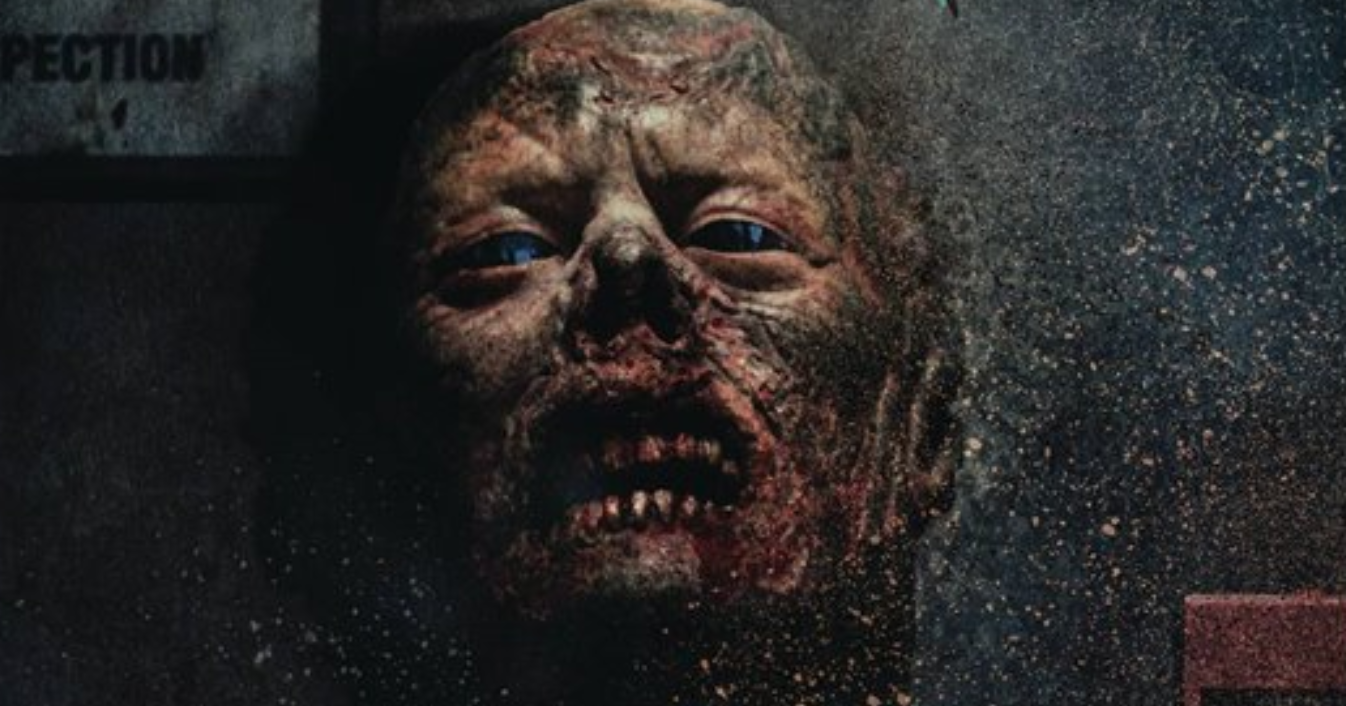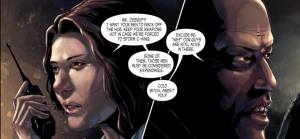I’ll be the first to admit that horror isn’t my cup of tea. Never got into the stuff, but I can appreciate the necessity of horror as a genre in the artistic ether. Horror is perhaps the most direct reflection on how we are doing as a society and the vicarious thrills of seeing blood, brains, and gore seep out are a good substitute for actual violence. But horror, and indeed, dark science fiction, works best when it’s satirical edge is particularly sharp and the potential for a multiplicity of interpretation is present. This is what makes John Carpenter’s Tales of Science Fiction anthologies, published by Storm King Productions, so enthralling and engrossing.
The Carpenter imprimatur on any project immediately raises the stakes and Storm King Productions lives up to its name by creating bold and forceful stories that challenge readers while also inducing heart palpitations with every turn of the page. Well, that certainly happened to me while reading the latest arc in the Tales of Science Fiction titled “The Standoff,” a yarn about a prison riot gone awry, hostage teams trying to stave off more violence, and a mysterious force sucking up post-mortal souls; it’s trippy stuff! Last month at San Diego Comic Con, I had the wonderful opportunity to interview some of the core team at Storm King, including Sandy King, David Schow (The Crow), and Janice Chiang. And even though there were hordes of slow moving bodies around us, our conversation was thoroughly delightful and insightful.
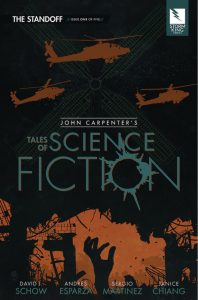
SANDY KING: I think the reason the Tales of Science Fiction came about was because when I looked at our booth one day and realized we had an ongoing series and we had a yearly anthology of horror short stories. But what was really missing for our fans was science fiction: Some people are hardcore horror fans. Others are more fantasy and outer space, or a combination. I thought, “Wow, you know, with the kinds of writers we work with, we need tales of science fiction. It was that simple; I felt like we had a gap
FROST: In your opinion, what’s the best way to reach all of those hardcore horror fans and those hardcore sci-fi fans and get them to meet? In essence, how do you create that crossover appeal?
KING: Spray blood around a spaceship! [Laughs]. You know, I think that there are lots of tropes throughout time—through movies like The Thing which is more horror—where you can go in different directions. So the idea was that by bringing in the best writers I know and to get their takes on what’s a science fiction story is. So that’s when you turn to someone like Mr. [David] Schow here and go, “Okay, buddy boy. Give me your best shot at science fiction!.” When you do that, you give our fans different takes in the genre.
DAVID SCHOW: Fans make these arbitrary distinctions between science fiction fantasy and horror, especially when they’re movie fans. What they’re really talking about 9 times out of 10 is usually: is it a monster movie or not? And that’s the crossover element. Do we have a monster horrific element, if you will? And then it doesn’t matter if it’s fantasy, science fiction, or horror because we’re all talking about the same genre really.
KING: Sure. And the big thing when people say “Is it a horror movie?”… Horror is not a subject, it’s a reaction. So you know you don’t write horror. You have horror.
SCHOW: Horror’s an emotion.
AJ FROST: How then do you best convey horror in a comic? In a movie you can have music to build tension; there are many editing techniques that raise the suspense. But in a comic book, readers can see everything laid out sequentially.
KING: You write suspense and you write cliffhangers; that’s the biggest thing. You have a cliffhanger with every page turn. There’s a different pacing in how you’re constructing it. And that’s what’s different from scriptwriting, in that you have to take into account that the reader is creating their own pace by how they turn the page and as you say you’re seeing two pages of story at a time. For me, coming from screenwriting, that was the deal where you sit there and you think “Wow I’ve written this and it really rocks” and then you go back the next day and feel nothing. That’s one of the challenges of writing in this genre.
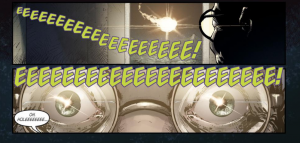
AJ FROST: David, what do you think?
SCHOW: The thing that you get out of comics that you don’t get out of movies is that when you get to the end of the two-page spread, you have to make the reader want to flip that page. It’s kind of the same as in print fiction: When you get to the end of a paragraph or the end of a section, you want them to turn the page again. The other aspects of graphic novels and comics are the cutting. It’s kind of there for movies the framing and cinematography are kind of there for movies if you work with really good artists. So it’s the same, but it has a foot in each camp.
KING: And that’s the thing with putting together the teams, from my end.
SCHOW: I think we have a great band with “The Standoff.”
JANET CHIANG: A lot of suspense-building has to do with pacing the dialogue. The cues I get from David are in the art direction and then I have to see how I’m just literally translating it to the page. Sometimes when he reads a script, he’ll change it a little bit; he has a better understanding of visual storytelling. So I have to make sure the dialogue fits with the flow. I represent the cadence; I’m the silent soundtrack. That’s a difference from a visual media or a soundtrack. With lettering—at least the best lettering—you don’t notice because it carries the readers through the experiences like, “Oh is that the right person speaking? Why is that balloon covering that guy’s head?” And the sound effects. In terms of tempo and rhythm and volume.
I’m in love with our team who worked on “The Standoff.” Everyone puts in 1000 percent. And from reviews of people we’re not related to, it’s such a compliment.
SCHOW: A couple of the reviews were like that it was like when the saw “To Be Continued…” was like slamming into a brick wall for them, which is exactly what you want. And Janice really has one of the hardest jobs there is, because she’s got to strategically portion out the dialogue and the captions and stuff in a way that makes your eye go from one panel to the next to the next even in the same scene. It’s all suspense building. It all goes back to Hitchcock.
FROST: A lot of horror is a reflection on how we are doing as a society. So I’m wondering how “The Standoff” fits into the zeitgeist of contemporary times, especially in terms of what’s going on politically?
SCHOW: I would say not at all and happily so because this is… Horror stories and fiction in general are a way for us to acid test these kind of human values that we think we have in a situation that doesn’t involve you getting your head blown off your guts ripped out. We have enough real world problems as it is. Let me hand you an unreal world problem and see how you will deal with that. Because we all already know everybody on social media knows how we react to the other stuff. Yes, it can be a reflection because people say that in bad political administrations, horror thrives. I’m sure you’ve read that somewhere and it looks like it’s thriving right now.
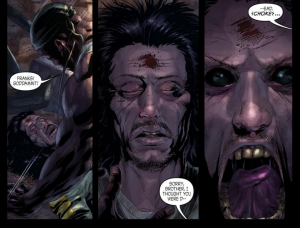
KING: We’ve done a lot of political satire. And speaking of “Halloween Nights,” you know Joe Harris is often doing some of our more political stuff. And it works. But I think something like “The Standoff”… we’re just blowing things up to release a lot of energy. We’re doing what we wish we were doing during the day.
AJ FROST: Horror really has a rich tradition in comics. As I’m sure you know, back in the 50s before everything went down with the Comics Code, horror was probably one of the most popular forms of comics. And I think in the last few years, there’s really been a renaissance especially in terms of the diversity of storytelling. I’m just wondering what your thoughts are about the historical aspect of horror in comics and where do you think horror in comics are going?
SCHOW: I think it’s a mistake to try to make horror so respectable that it gets a wider sort of audience. I think we really need to have a concerted effort to put the horror back in the gutter where it belongs. Horror has always been a disreputable genre. Horror has always been the bad part of town; the one seedy bar that you really want to go to. And I think that’s the part that we shouldn’t lose, getting more eyes on the product and on the rise. But not at the cost of sanitizing it. The perfect example is the PG-13 rating in movies, where everything is mandated to be one way. I mean, if you’re just watching movies you don’t have much of a choice between a forensic sort of torture film and all the way back to possessed children in haunted houses again. There are other varieties. It’s like a Baskin Robbins with only two flavors… but we have 31 flavors sitting right here!
KING: I think the fun of doing the anthology once a year is to try and make it so no two stories sound the same. There’s no two haunted houses, no two monsters under the sea. You try and get the psychological horror and all of it. And that’s one of the reasons I chose to reach outside the traditional world of horror to bring novelists, movie writers, everybody else. My thought was “Come on in. I’ve got a barn, let’s make a movie!”
CHIANG: Every time I start a new storyline, I tell my husband I’m doing a new project. So, when we were about to start “The Standoff,” he asked me to explain what it is. So finally I said, “Basically a prison riot and they’re fighting cops and authorities internally, and externally the authorities are working with how to handle this rebellion. And meanwhile, the nth element is these aliens. And you know at first it’s like, “Oh my God. How are they going to get out of this?” But then you see the irony. And it becomes humorous. It’s like, “What would you do? Who would you be? Would you be inside, outside or do you side with the aliens?”
SCHOW: Imagine the best western ever made: If you and I are sitting behind a wagon and guys are shooting at us we’re shooting back at the guy, you and I would turn to each other and say some kind of wisecracked thing. It’s not making comedy out of it, but it’s the only way you leaven that tension. You read a comic and it looks like it’s horror comic and then is a science fiction comic and then it’s then it’s a suspense thing and it’s like we want to keep you guessing, we don’t want to label. We want to keep you guessing as to what it is. That’s part of our job.
AJ FROST: How would you recommend people come to this? How would you describe to someone who has no expectations of what they’ll see inside these pages?
KING: It’s something I’ve never seen before.
SCHOW: I would say if you want a new flavor in this ice cream parlor of horror, check it out.
CHIANG: As I say to people, the John and Sandy Carpenter brand: expect the unexpected.
KING: There’s different approaches in terms of like the Vault was for people that like things like sunshine and a good horizon. Vortex [another Storm King Productions title] was like the thing for in outer space. The deal with “The Standoff” is, like, a spaceship crash lands in a high-security prison. You know what can go wrong? I think it’s got a great adventure. David always writes with a great dark humor. It’s kinda just a balls-out adventure, that happens to have a few otherworldly things going on. You’re going to have a good time.
SCHOW: One thing I like about the version of this comic that we’re doing is that Tim Bradstreet has been doing variant covers for the different issues and I’ve never seen variant covers for a single comic, look so different within the selection of variance. I think that’s another good sign. One of the best things that you can say about a book like this is that it would be a great story if it didn’t have the aliens in it!
KING: I think that’s it!
FROST: Any final thoughts?
KING: Mostly what we try and do is entertain and break the expectations. It’s like we’re launching the app so that people can find us easily. We launch it with an Augmented Reality cover. For fun. And the whole point of that was, if John Carpenter’s in a field, there’s usually something different about it. So that’s what we try to reflect. Each of the stories, each of the lines. And for the fun of it, augmented reality covers. Because nobody’s doing it. One of the things I look for is to represent a world John would like to inhabit on film, in readings. We’re supplying what we would do in any genre. But we’re meeting that kind of expectation and not just cloning it.
“The Standoff” and other Storm King Productions comics can be found at https://www.stormkingproductionsstore.com/


